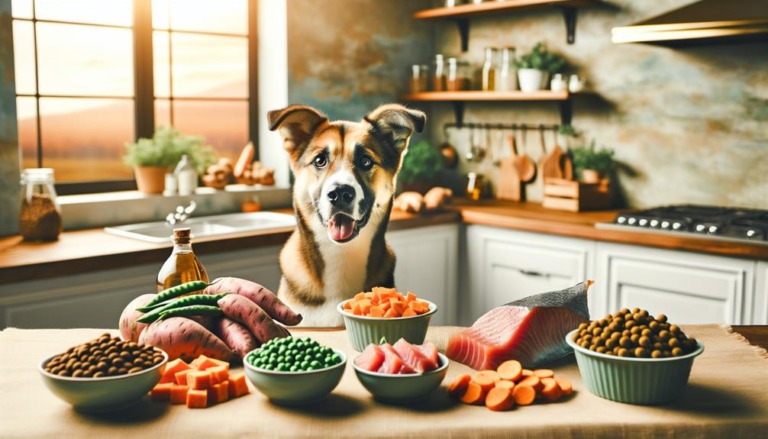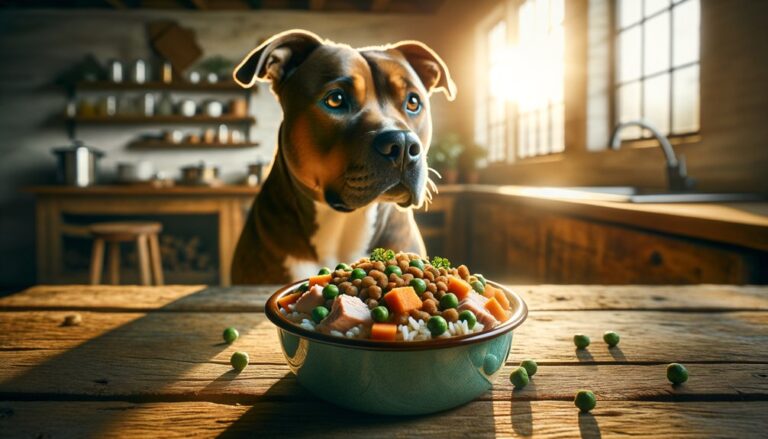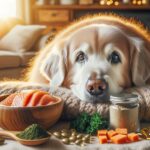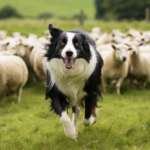The Best Fluffy Pancakes recipe you will fall in love with. Full of tips and tricks to help you make the best pancakes.

A practical guide to safely preparing and handling raw or home-cooked dog meals—discover essential precautions, common pitfalls, and when to consult a pro. You might think raw or home-prepared dog diets are inherently risky, but the real picture is more nuanced and manageable. You can reduce bacterial and parasitic hazards with proven hygiene, temperature control, and trusted suppliers. If you want meals that meet nutritional needs and keep your household safe, there are concrete steps and professional checks to follow — and a few common mistakes that usually cause problems.
Key Takeaways
- Work with a board-certified veterinary nutritionist to design and test balanced home-prepared or raw diets before feeding.
- Assume raw proteins can carry pathogens; prevent household exposure with strict hygiene and dedicated prep areas.
- Store at ≤0°F (-18°C), label portions
- Use separate utensils and sanitize surfaces with hot soapy water then a bleach or EPA-registered disinfectant.
- Monitor your dog’s health with baseline and periodic bloodwork and adjust diet under veterinary supervision.

Why Safety Matters When Feeding Raw or Home-Prepared Meals
Feeding your dog raw or home-prepared meals can feel like a caring, intentional choice. But it’s not risk-free. Scientific studies show that over 20% of commercial raw diets for dogs test positive for Salmonella, while up to 30% of dogs fed raw protein shed harmful bacteria such as Salmonella or E. coli in their feces, contaminating the household environment.
In the UK, dogs on raw diets were found to be three times more likely to carry antibiotic-resistant E. coli compared to dogs fed conventional diets. And nutrition matters too: a study of 200 home-prepared diets revealed that 95% were deficient in at least one essential nutrient, most commonly calcium, vitamin D, and zinc.
This isn’t a fringe practice anymore. Surveys show that nearly 50% of dog owners in the Netherlands feed raw diets either partially or exclusively, reflecting a global trend toward alternative feeding.
Raw Feeding and Zoonotic Transmission
Raw diets don’t just affect dogs—they can impact humans too.
- Dogs fed raw diets – shed – pathogens into household environments
- Pathogens – transmit – zoonotic infections to humans
- Unsafe handling – increases – risk of Salmonella outbreaks in families
Safe Raw Dog Food Preparation Tips
To reduce risks, focus on evidence-based safety practices rather than “safety theater”:
- Hygiene: Wash hands, utensils, and surfaces thoroughly after handling raw food.
- Temperature control: Keep meat below 4°C (40°F) and never leave it unrefrigerated.
- Proper storage: Portion meals into clean containers and refrigerate or freeze promptly.
- Cross-contamination prevention: Use separate cutting boards for raw meat and other foods.
Nutrient Balancing Strategies for Home-Prepared Diets
Home-prepared diets often lack balance. Data shows:
- 95% – deficient in – at least one nutrient
- 83% – deficient in – calcium
- 75% – deficient in – vitamin D
- 60% – deficient in – zinc
These deficiencies create direct health outcomes:
- Calcium deficiency – increases – risk of fractures
- Vitamin D deficiency – causes – weakened immune system
- Zinc deficiency – results in – poor skin and coat health
Long-Term Risks and Outcomes
- Raw feeding without safeguards – increases – household contamination risk
- Evidence-based preparation – lowers – illness incidence in dogs and families
- Consistent safe practices – maintain – trust in pet owner communities
- Balanced diets – support – long-term bone, immune, and metabolic health
Sources
BMC Veterinary Research – Prevalence of raw feeding in dogs
PLOS One – Raw feeding and resistant bacteria
JAVMA – Nutritional adequacy of home-prepared diets
Choosing Safe Ingredients and Trusted Suppliers
You should prioritize high-quality protein sources with clear origin, handling, and pathogen-control records to reduce infection risk. Choose fruits and vegetables approved suppliers’ safety practices and ask for documentation (e.g., sourcing, testing, and storage) before trusting their products.
Source High-Quality Proteins
Selecting high-quality proteins is the cornerstone of a safe home-prepared or raw diet, so prioritize cuts with clear provenance, minimal additives, and appropriate nutrient profiles for your dog’s life stage. You should choose protein sources that deliver complete amino acids and are fresh or properly frozen to reduce bacterial risk. Check labels and ask suppliers about sourcing integrity, animal rearing practices, and processing steps. Prefer single-ingredient meats or whole prey items from reputable butchers, certified farms, or trusted commercial raw brands that document testing and traceability. Balance organ, muscle, and bone according to a vet-formulated plan. Prioritize ingredient safety g’s health and join a community focused on responsible feeding.
Vet-Approved Produce Choices
How do you pick fruits and vegetables that truly benefit your dog’s home-prepared or raw diet? Start with vet approved produce choices: prioritize items low in toxins (no grapes, raisins, onions, garlic) and rich in fiber and micronutrients (pumpkin, carrots, spinach in moderation). Buy from trusted suppliers who test for pesticides and pathogens; local organic farms or certified distributors reduce risk. Wash and, when needed, blanch to lower bacterial load. Measure portions to match your dog’s caloric needs and monitor stool, energy, and allergies. Share decisions with your veterinary team so choices stay individualized and safe. You’re not alone—use evidence-based guidelines and supplier transparency to build a balanced, communal approach to feeding your dog.
- Bright-orange pumpkin, steamed
- Shredded carrot, raw
- Lightly wilted spinach
Reducing Bacterial and Parasitic Risks During Preparation
When you prepare raw or home-cooked meals, follow strict safe-food-handling steps—wash hands for 20 seconds, sanitize surfaces, and keep raw proteins refrigerated until use. Use separate cutting boards, utensils, and containers for raw pet ingredients to prevent cross-contamination with human foods. Regularly sanitize equipment and discard any food that’s been left at room temperature for more than two hours.
Safe Food Handling
Why should you treat raw ingredients and preparation surfaces as potential sources of pathogens? You should assume risk, because safe handling and kitchen sanitation reduce bacterial and parasitic exposure for you and your dog. Clean, deliberate steps protect immune‑compromised household members and foster group confidence in feeding choices.
- A soiled counter with dripping chicken: visualize microbes spreading into crevices.
- Hands handling multiple items: imagine transferring organisms from meat to utensils.
- Unrefrigerated mixes left hours: picture bacterial growth multiplying rapidly.
Follow evidence-based routines: wash hands 20 seconds, sanitize surfaces with appropriate agents, keep temperatures cold, and use dedicated tools. You’ll belong to a community that values safety and clear, reproducible practices when preparing raw or home-prepared diets.
Preventing Cross-Contamination
Having clean hands, surfaces, and tools lowers the chance that pathogens from raw ingredients reach your dog’s food or your household. You should assume raw protein can carry bacteria and parasites; prevent cross contamination tent kitchen hygiene so everyone who prepares food feels supported and clear about steps.
| Action | Why it matters | How often |
|---|---|---|
| Handwashing | Removes pathogens | Before/after prep |
| Separate utensils | Prevents transfer | Every meal prep |
| Sanitize surfaces | Kills bacteria | After each use |
| Store properly | Limits growth | Immediately refrigerate |
Follow these practices as a group norm; they reduce risk and build trust among caregivers.
Balancing Nutrition: Macronutrients, Micronutrients, and Supplements
How do you ensure a home-prepared or raw diet meets your dog’s needs without guesswork? You aim for balanced macros while watching for micronutrient gaps that commonly occur in DIY plans. Focus on protein, fat, and carbohydrate proportions that match your dog’s life stage and energy needs, and include diverse whole-food sources to reduce single-source deficiencies.
- Visualize a plate: lean muscle protein, species-appropriate fats, and limited digestible carbs.
- Picture variety: organ meats, muscle meat, and vegetables to cover vitamin and mineral ranges.
- Imagine supplementation: targeted additions for nutrients hard to obtain reliably from whole foods.
Use evidence-based reference targets and avoid improvising with trends. Where foods vary seasonally or of caregivers who prioritize measurable nutrition — make choices you can document and reassess.
Working With a Veterinary Nutritionist and Getting Tests Done
Who should you call when DIY nutrition gets uncertain? You should contact a board-certified veterinary nutritionist or a clinic offering veterinary collaboration. They’ll review your recipe, ingredient sources, and feeding goals, and they’ll spot nutrient gaps or excesses using evidence-based methods.
Expect an initial plan that includes baseline bloodwork, urine analysis, and when appropriate, specific nutritional testing (e.g., taurine, vitamin D, fatty acid profiles). These objective measures let you and the specialist track status, adjust supplements, and prevent deficiency or toxicity. Ask for written ration analyses and clear follow-up intervals.
Stay involved: bring diet logs, portion sizes, and commercial product labels. A nutritionist will teach you measurable targets, interpret lab trends, and recommend rechecks after diet changes. This collaborative approach minimizes risk and builds confidence—you’re not alone in optimizing your dog’s health.
Safe Storage, Thawing, and Serving Practices
Once your nutritionist has approved a recipe and testing plan, you’ll need clear procedures for storing, thawing, and serving to keep that plan safe and effective. Follow storage guidelines: label portions with date and batch, freeze at 0°F (-18°C) or colder, and rotate stock so oldest is used first. Use airtight containers to limit freezer burn and nutrient loss.
Thawing protocols should prioritize food safety and nutrition: thaw in the refrigerator on a plate to catch drips, use within 24–48 hours once fully thawed, or thaw in a sealed bag under cold running water for faster use. Never leave raw food at room temperature for extended periods.
When serving, portion onto a clean dish, return unused refrigerated portions promptly, and feed within recommended timeframes to preserve nutrient balance. These steps help you protect your dog and share confidence with others caring for them.
- Labeled, portioned packages in the freezer
- Refrigerator or cold-water thawing
- Prompt serving and return of leftovers
Protecting Your Household: Cleaning, Cross-Contamination, and Waste Handling
Keeping raw and home-prepared dog food in your home means you must treat surfaces, tools, and waste as potential contamination sources and act to eliminate them immediately. You’ll sanitize handling surfaces with hot, soapy water, then a bleach solution (1 tbsp/qt) or EPA-registered disinfectant; rinse and air-dry. Prevent cross contamination sealing waste and cleaning bins frequently.
| Task | Frequency | Best Practice |
|---|---|---|
| Surface cleaning | After prep | Hot water + detergent, disinfect |
| Utensil separation | Always | Dedicated or dishwasher‑safe |
| Waste disposal | Daily | Seal, double‑bag if raw |
| Odor control | Weekly | Clean bins, baking soda |
| Cross‑contamination check | Before serving | Visual check, glove use |
Dispose of raw food waste promptly; use sealed outdoor containers and weekly pickup. You’re protecting household members and pets
Frequently Asked Questions
Can Raw Diets Affect Human Pregnancy or Breastfeeding Safety?
Yes — raw pregnancy and breastfeeding safety can be impacted; you’ll face dog diet risks like Salmonella or Listeria exposure, so you should avoid direct contact with raw pet food, practice strict hygiene, and consult your clinician.
How Do I Safely Travel With Raw or Home-Prepared Dog Meals?
Want safer travel with your dog’s meals? You’ll pack chilled, sealed containers, use insulated coolers and ice packs, label contents, follow airline and local travel safety rules, and prep portions to minimize handling and ensure hygienic meal prep transport.
Are There Breed-Specific Risks for Raw Feeding?
Yes — you’ll face breed-specific risks with raw feeding: breed specific risks include genetic sensitivities, size-related nutrient needs, and breed variability in metabolism; ensure nutrition balance, consult your vet, and join supportive breed communities for guidance.
Can Dogs With Autoimmune Diseases Eat Raw Diets?
You shouldn’t assume can autoimmune disease dogs tolerate raw diet safety; consult your vet. You’ll need tailored dietary restrictions for immunocompromised pets, strict hygiene, and consider raw feeding disease transmission concerns before deciding.
What Pet Insurance Covers Diet-Related Illnesses?
About 60% of insurers exclude diet-related conditions; you should check policy specifics. You’ll want insurers offering Insurance coverage for gastrointestinal disease and clear Veterinary billing itemization, so you’re included and claims aren’t unexpectedly denied.
Conclusion
Feeding raw or home-prepared meals can be safe if you follow evidence-based steps: source trusted ingredients, use dedicated tools, sanitize thoroughly, control temperatures, and work with a veterinary nutritionist. One CDC estimate found raw pet food was linked to 70% of documented Salmonella outbreaks tied to pet food, underscoring why strict precautions matter. Stay vigilant with testing, storage, and waste handling to protect your dog and household.









